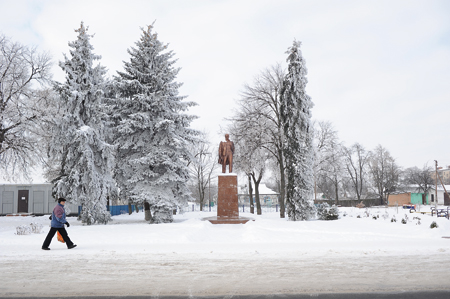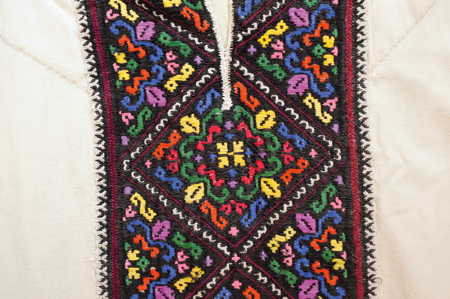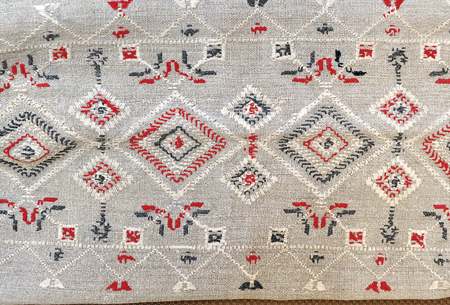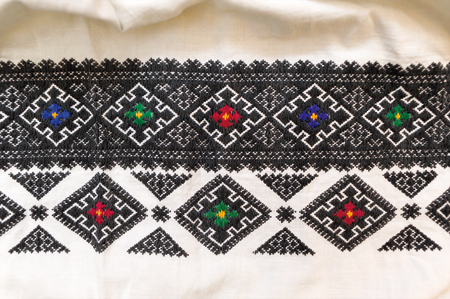Ukraine has generally recognized centers of folk crafts: Opishne (Poltava) is famous for its pottery, Kosmach (Hutsul region) for carpet weaving, and Buda (Kharkiv oblast) for glazed earthenware, while in Petrykivka boys and girls are taught the local art of painting in childhood. But where are embroidered shirts produced? Well, all across Ukraine (and even in China, they say). But some regions are steeped in the tradition of embroidering.
Workshops in Reshetylivka
Reshetylivka (Poltava oblast) has long held the title of a designing center and confirmed this once again when Ukraine regained its independence. Neither the demise of the USSR, nor the collapse of the large local clothes factory forced hundreds of craftsmen that specialize in fine handiwork to abandon their craft. Only a handful switched to other activities, while for the majority embroidering is still their bread and butter.
The local handicraftsmen do not feel the need to advertize their center. They are certain that the true connoisseurs know them anyway.
“Our female artisans are the best,” says Natalia Bihun, principal of the local professional arts lyceum. This is where they teach how to make national costumes. What students take here are no ordinary classes — these are master classes taught by officially recognized folk artisans.
Nadia Vakulenko is one of them. In 2007, she had the honor of representing Ukraine at the World Ethnic Arts and Culture Festival in Seoul with her work. South Koreans could not believe that the designs on her shirts were truly hand made and not reproduced from computer graphics.
“I have only a superficial acquaintance with computers. What computer graphics can you speak about? Collectors commission me to make special, unique pieces that turn out to be tedious and time-consuming, and every stitch on them is made by these hands. One embroidered piece took me three months to complete because the client wanted embroidery on the marquisette. As they say, any client's wish is the law for us, especially when they pay UAH 10,000,” says Ms. Vakulenko as she eagerly shares the details of her professional work.
She smiles as she speaks about how she once had to embroider wedding clothes following the principles of feng shui. The colors of the designs on the tunics to be worn by the bride and the bridegroom who followed the popular Oriental teaching had to match the colors and symbols on their chakras.
Eastern and central regions of Ukraine have characteristically pastel shades in embroideries, says Ms. Bihun. The vegetable dyes used to dye threads back in the 19th century produced pale colors. Those who did not care for this paleness used ordinary, undyed threads. That is the origin of the popular black-on-white, blue-on-white, and gray-on-white motifs. All of these are classical designs produced in Reshetylivka. There is also openwork — a special technique when the horizontal threads are pulled out from fabric, while the vertical ones are joined together in a variety of patterns.
“In general, we teach a hundred different ways to embroider: the curly technique, the grainy technique, and so on. We also teach western Ukrainian methods. They are special — very vivid and immediately eye-catching,” says the principal.
The students’ professionalism is tested with the task of copying the so-called Tree of Life, a symbol of Ukrainian folk art.
“This is a hard task. This symbol combines a great many other symbols. Irises are a talisman against the evil force; the full cup means prosperity, flowers love, ears of wheat riches, and nestlings children. However, year after year, depending on their specialization, students weave, embroider, or paint the Tree of Life. So they know our how wise our ancestors were,” Ms. Bihun explains.
The UN also knows about their wisdom: a tapestry with this name which was made by the local painter Nadia Babenko is featured in the Blue Room in the UN headquarters in New York.
Most valuable dowry
There are quite a few villages in Ukraine, such as Vovchkivtsi in Ivano-Frankivsk oblast, where embroidery is not considered something unusual or perceived as a souvenir.
You will find embroidered clothes in every household, and dowries including embroidered work begins being assembled when the future bride is still a small child.
Maria Levko embroidered the first blouse for her great-granddaughter Ilona when Ilona turned three. Now the tiny piece of fabric with embroidered blue cornflowers is part of her doll Khrystynka’s stock of clothes, while Ilona herself has the complete set a young girl needs: an embroidered shirt, a zapaska (a kind of skirt that is wrapped around the waist without being sown together), a pidtychka (lower part of a woman’s dress, usually made of thicker cloth), an okriika (an embroidered sash), multicolored ribbons, and a wreath. All of this was handmade by her great-grandmother.
Several women in Vovchkivtsi also embroider for their fellow villagers. One of them, Alla, says: “I’ve got enough work, especially during the periods of fasting when there are no weddings. This is the peak for orders. Every girl, whether small or grown-up, wants to have a national costume to be ready for the role of a bridesmaid at a wedding. The same goes for the boys and young men.”
To be a bridesmaid or the best man is a special honor and the role cannot be filled without embroidered clothes — the day before the marriage ceremony is held in church the bride and bridegroom, accompanied by their escorts wearing national costumes, wend their way around the village to invite honored guests to the event: the priest, the village head, school principal, and class teacher.
A woman speaks about the trends: “The young people’s fashion is now monotonous. It has come from the local center, from Poltava oblast. In contrast, our embroidered work is, in my opinion, more colorful, saturated, and passionate. It emphasizes the character of highlanders.”
“It is important not to lose this heritage in order to preserve and develop the authentic embroidering techniques. Embroidered shirts were like the passports of villages, so to speak. And even within one village you would not find two identical items — every girl would add her own special features,” says Yaroslava Osadtsa, a folk artisan and member of the Vertep society which is working to revive the half-forgotten embroidering techniques in the Ternopil area. “They also preserved history. One sleeve could feature up to 16 embroidering techniques. It would be wonderful to have a catalogue of embroidering surviving in various places, in every village.”
Traditions and modern times

Ruslan Pavliuk, head of the research unit at the Shliakhetny Odiah Authentic Costume Workshop, says:
“We need to understand that patterns have some attribution… Knowledge has been lost almost completely, but understanding remains. Traditional women knew that in order to have an easier time during childbirth, they had to embroider the shoulders of their blouses with red rhombs. But a contemporary woman is surprised to see this traditional Poltava pattern, Why isn’t is black-and-red? Why isn’t it cross-stitched? Why these Turkish patterns? Embroidering involves deep knowledge that is not self-explanatory.
“In the past century, the Ukrainian embroidered shirt has taken the shape of a trend that is a fig leaf covering traditional ignorance. Remember that a shirt, regardless of how nicely embroidered it is, is a piece of underwear. To wear it on a holiday over the pants and without putting on some outer clothes is poor taste formed by Soviet kitsch. In ‘traditional’ times, the head of a family would not leave his household wearing a shirt, and young guys would put a sweater over their shirts when they went out, even in the summer.”

WHITE ON WHITE. Pale shades are now more popular than vivid colors

EMBROIDERING CENTER. Outwardly, Reshetylivka is not much different than other Ukrainian villages.

WITH A TAMBOUR IN HAND. One item may take up to three months to complete.

IN A MUSEUM. These dolls and painted Easter eggs were made by Reshetylivka Lyceum students.

IVANO-FRANKIVSK REGION PATTERN

RIVNE REGION PATTERN

VINNYTSIA REGION PATTERN

POLTAVA REGION PATTERN

